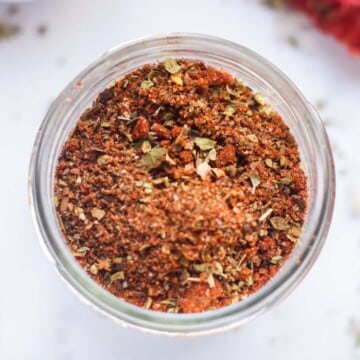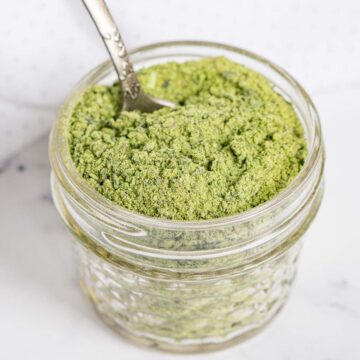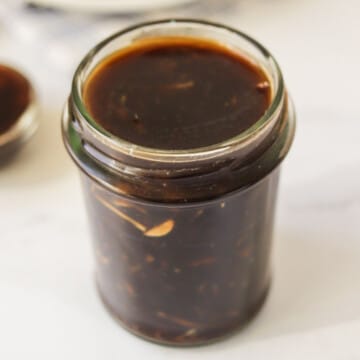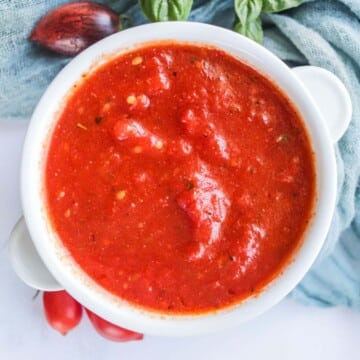This Low Calorie Pineapple Habanero Sauce is a fiery fusion of tropical sweetness and bold heat. Made with pineapple and habanero peppers, this sauce delivers a balance of flavors!

Jump to:
Check out my Cilantro Chimichurri Sauce and my Raising Cane's Sauce Recipe for more amazing sauce recipes!
Crafted to perfection, this low calorie pineapple habanero sauce brings together the essence of pineapple and the bold punch of habanero peppers.
Perfect for storing in the refrigerator for up to three weeks or freezing for long term enjoyment!

Why You'll Love This Recipe
- Whether you're a fan of spicing up your grilled meats, adding zest to tacos, or seeking a unique sauce for dipping, this sauce has got you covered.
- The sauce brings together the combination of tropical sweetness from pineapple and the bold heat of habanero peppers.
- You have the flexibility to adjust the spiciness to your liking.
Ingredients You'll Need

- Pineapple Chunks: Providing a burst of tropical sweetness and complements the heat of the habanero peppers.
- Habanero Peppers: Handle them with care because their heat can be quite potent. You can remove the seeds and stems to help control the level of spiciness.
- Onion: Adds depth and a savory note to the sauce.
- Garlic: Complements the sweetness of the pineapple and adds another layer of flavor.
- Apple Cider Vinegar: Provides acidity to balance the sweetness of the pineapple.
- Lime Juice: Adds a zesty, citrusy note.
- Honey: Adds natural sweetness and complements the tropical flavor of the pineapple.
- Salt: Enhances the overall flavors.
Step-By-Step Instructions

Step 1: Prepare the habanero peppers by removing the stems and seeds. Be sure to wear gloves or handle them with caution, as habaneros can be quite spicy and may irritate the skin.
Step 2: In a blender or food processor, combine the pineapple chunks, habanero peppers, diced onion, minced garlic, apple cider vinegar, lime juice, honey, and salt. Blend until you achieve a smooth consistency.
Step 3: Pour the mixture into a saucepan and bring it to a simmer over medium heat. Reduce the heat to low and let it simmer for about 10-15 minutes. Stir occasionally to prevent sticking.
Step 4: After simmering, remove the saucepan from the heat and let the sauce cool down for a few minutes.
Step 5: Once the sauce has cooled slightly, pour it back into the blender or food processor and blend it once again for a smoother texture.
Step 6: Taste the sauce and adjust the seasoning according to your preference.
Step 7: Transfer the sauce to a clean, airtight jar or bottle. Allow it to cool completely before sealing.
NOTE: You can print the FULL recipe with all ingredients & detailed instructions below!

Expert Tips
- When handling habanero peppers, it's crucial to wear gloves. The oils from the peppers can cause skin irritation and discomfort. Avoid touching your face, especially your eyes, while working with them. After handling the peppers, wash your hands thoroughly with soap and water.
- The heat level of habanero peppers can vary, so it's a good idea to taste a small piece before using them in the sauce. If you prefer a milder sauce, remove all the seeds and membranes from the peppers. For a spicier kick, leave some or all of the seeds in.
Variations
- Fruit: Experiment with different tropical fruits like mango, papaya, or kiwi, alongside the pineapple.
- Citrus: Enhance the tanginess by incorporating other citrus fruits like orange or grapefruit juice in addition to the lime juice.
- Herb: Introduce fresh herbs like cilantro or mint to the sauce for a herbal twist.
Storing & Freezing
Storing: Before storing the sauce, allow it to cool down to room temperature. Transfer the sauce to a clean, airtight jar or bottle. Store the sauce in the refrigerator for up to 3 weeks.
Freezing: Allow the sauce to cool down completely after cooking. Use freezer safe containers or resealable plastic bags for freezing. It can be frozen for up to 6 months. However, for the best quality and taste, try to use it within 3 to 4 months.
Recipe FAQ's
Yes, you can use canned pineapple chunks in this recipe. Just make sure to drain the pineapple before blending it with the other ingredients.
Yes, if you prefer a different level of heat or have a different type of chili pepper available, you can substitute habanero peppers with other varieties like jalapeno, serrano, or Thai bird chilies.
The sauce is versatile and can be used as a glaze for grilled meats, a topping for tacos or pizzas, a marinade for chicken or shrimp, a dipping sauce for appetizers, or even as a salad dressing.
More Recipes You'll Love

Low Calorie Pineapple Habanero Sauce
Special Equipment
Ingredients
- 2 cup pineapple chunks fresh or canned
- 3 habanero peppers
- 1 small onion diced
- 3 cloves of garlic minced
- ¼ cup apple cider vinegar
- ¼ cup lime juice
- ¼ cup honey
- 1 teaspoon salt
Instructions
- Prepare the habanero peppers by removing the stems and seeds. Be sure to wear gloves or handle them with caution, as habaneros can be quite spicy and may irritate the skin.
- In a blender or food processor, combine the pineapple chunks, habanero peppers, diced onion, minced garlic, apple cider vinegar, lime juice, honey, and salt. Blend until you achieve a smooth consistency.
- Pour the mixture into a saucepan and bring it to a simmer over medium heat. Reduce the heat to low and let it simmer for about 10-15 minutes to allow the flavors to come together. Stir occasionally to prevent sticking.
- After simmering, remove the saucepan from the heat and let the sauce cool down for a few minutes.
- Once the sauce has cooled slightly, pour it back into the blender or food processor and blend it once again for a smoother texture.
- Taste the sauce and adjust the seasoning according to your preference.
- Finally, transfer the pineapple habanero sauce to a clean, airtight jar or bottle. Allow it to cool completely before sealing.
Notes
- When handling habanero peppers, it's crucial to wear gloves. The oils from the peppers can cause skin irritation and discomfort. Avoid touching your face, especially your eyes, while working with them. After handling the peppers, wash your hands thoroughly with soap and water.
- The heat level of habanero peppers can vary, so it's a good idea to taste a small piece before using them in the sauce. If you prefer a milder sauce, remove all the seeds and membranes from the peppers. For a spicier kick, leave some or all of the seeds in.
- Storing: Before storing the sauce, allow it to cool down to room temperature. Transfer the sauce to a clean, airtight jar or bottle. Store the sauce in the refrigerator for up to 3 weeks.
- Freezing: Allow the sauce to cool down completely after cooking. Use freezer safe containers or resealable plastic bags for freezing. It can be frozen for up to 6 months. However, for the best quality and taste, try to use it within 3 to 4 months.
Nutrition
All nutritional information is based on third-party calculations and should be considered estimates. Actual nutritional content will vary with brands used, measuring methods, portion sizes and more.











Comments
No Comments